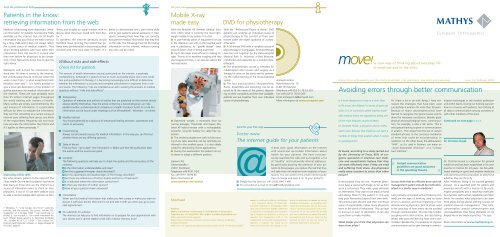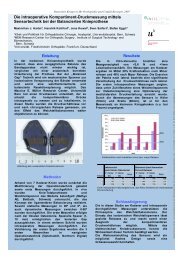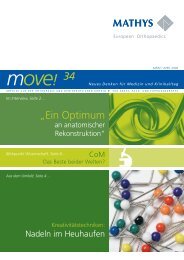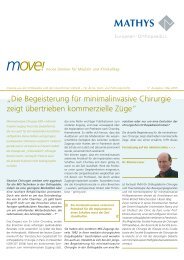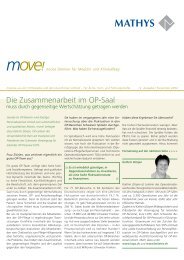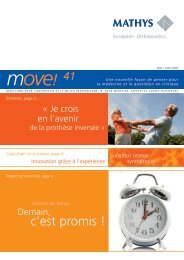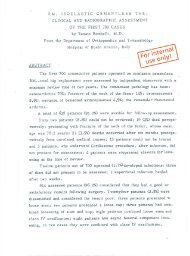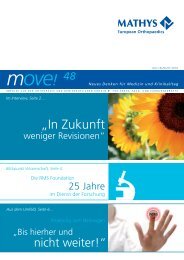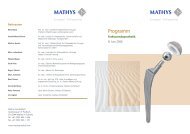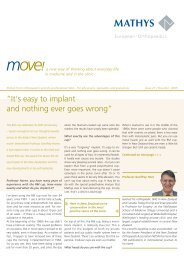move! - Mathys AG Bettlach
move! - Mathys AG Bettlach
move! - Mathys AG Bettlach
Create successful ePaper yourself
Turn your PDF publications into a flip-book with our unique Google optimized e-Paper software.
from the professional fi eld<br />
Patients in the know:<br />
retrieving information from the web<br />
Medicine is becoming more democratic. Medical<br />
information for patients has become freely<br />
available on the internet. But not all health<br />
information that you fi nd on the web is serious<br />
by a long chalk and it does not always refl ect<br />
the current status of medical research. Thus<br />
when treating patients who have taken their<br />
information from this source it is more vital<br />
than ever before for physicians to be competent<br />
in their fi eld and to know how to give the<br />
right advice.<br />
WPatients with a thirst for information can<br />
drink their fi ll when it comes to the internet.<br />
But unfortunately they do not know where the<br />
water comes from,“ is what anaesthetist Faith<br />
McLellan once said [1] . It is hardly possible to<br />
give a more apt description of the problem of<br />
quality assurance for medical information on<br />
the internet. There are now probably more<br />
than 25 million internet pages throughout<br />
the world dealing with matters of health.<br />
Many surfers are simply overwhelmed by this<br />
vast amount of information. It is particularly<br />
diffi cult for them to evaluate the information<br />
they can fi nd. According to a current survey of<br />
internet users suffering from cancer, two thirds<br />
of the respondents frequently did not know<br />
how accurate the information they fi nd is and<br />
if it applies to them personally. [2]<br />
Improving online skills<br />
But what attracts patients to the internet? The<br />
Swiss Health On the Net Foundation has found<br />
that many of those who use the internet as a<br />
source of information want to check on their<br />
physicians. 6 out of 10 use their website visits<br />
to seek a second independent opinion on their<br />
[1] McLellan, F.: “Like hunger, like thirst”: patients,<br />
journals, and the internet, The Lancet, volume 352,<br />
Supplement 2, 3 October 1998. [2] Vgl. Kirschning, S.;<br />
Michel, S.; von Kardoff, E.: Der online informierte Patient:<br />
Offener Dialog gesucht; in. Deutsches Ärzteblatt<br />
101, number 46 of 12.11.2004. [3] See Lindner, M.:<br />
Internet macht Patienten schlauer; in: Tages-Anzeiger of<br />
6.6.2000, page 42.<br />
illness and roughly an equal number wish to<br />
discuss what they have found with their doctor.<br />
[3]<br />
To condemn the internet generally would<br />
therefore mean ignoring the interest that patients<br />
have demonstrated in becoming actively<br />
involved with their own state of health. It is<br />
Without risks and side-effects<br />
Check list for patients<br />
better to demonstrate one‘s own online skills<br />
and to give patients special assistance in their<br />
search, showing them how they can correctly<br />
evaluate the medical information that they fi nd<br />
on the web. The following check list for fi nding<br />
information on the internet, without running<br />
any risks, can be a start.<br />
The amount of health information around, particularly on the internet, is positively<br />
overwhelming. Although it is good to know as much as possible about one‘s own condition<br />
and possibilities for therapy, it is becoming increasingly more diffi cult to determine<br />
whether the information is accurate and complete and whether it originates from a serious<br />
source. The following 7 tips are intended as an aid in seeking the answers to medical<br />
questions without “risks and side-effects“.<br />
Transparency<br />
Operators of websites and authors of articles that are published on the internet should<br />
always identify themselves. Was the article written by a trained physician, an independent<br />
author, a pharmaceutical company or a health insurance fund? As a rule this<br />
information can be found under headings such as Wmasthead“, Wcontact“ or similar.<br />
Healthy mistrust<br />
You should generally be suspicious of sensational healing promises, superlatives and<br />
claims to exclusivity.<br />
Crosschecking<br />
Always consult several sources for medical information. In this way you can fi nd out<br />
whether there are any differing opinions.<br />
State of the art<br />
Find out how “up to date“ the information is. Make sure that the publication date,<br />
the author and the sources are given.<br />
Contents<br />
The following questions will help you to check the quality and the seriousness of the<br />
contents:<br />
Is the information understandable and clear?<br />
Are the suggested therapies clearly described?<br />
Are the advantages and disadvantages of the therapy described?<br />
Are there any indications of further studies and forms of treatment?<br />
Is it indicated where the information comes from?<br />
Is there any mention of further sources?<br />
Have all your questions been answered?<br />
Consultation<br />
When you fi nd medical information that makes you feel uneasy or makes you want to<br />
discuss it with your doctor, then print it out and take it with you when you go to your<br />
next appointment.<br />
No substitute for a doctor<br />
The internet can help you to fi nd information or to prepare for your appointment with<br />
your doctor, but it cannot replace a talk with a doctor that you trust!<br />
For your use<br />
Mobile X-ray<br />
made easy<br />
With the Mobilett XP, Siemens Medical Solutions<br />
offers what is currently the most lightweight<br />
mobile X-ray system in its class.<br />
A user-friendly piece of equipment for use<br />
in the intensive care unit, in the hospital ward<br />
and in paediatrics; its “giraffe design“ takes<br />
away children‘s fear of being examined.<br />
Up to ten times more effi cient in taking images.<br />
Thanks to its excellent imaging with very<br />
short exposure times, it can also be used in the<br />
neonatal ward.<br />
Optimised weight; a motorised drive for<br />
narrow passages, thresholds and slopes; Mobilett<br />
XP hybrid version with a rechargeable,<br />
powerful, long-life battery for cable-free operation.<br />
The revolving double arm with its fully rotating<br />
X-ray tube assembly can be optimally positioned<br />
in the smallest space. It is also ideally<br />
suited for demanding clinical applications.<br />
During the examination the patient can sit,<br />
lie down or adopt a different position.<br />
Siemens <strong>AG</strong><br />
Siemensstraße 1<br />
91301 Forchheim<br />
Telephone +49 9191 18-0<br />
Fax +49 9191 18-99 65<br />
More information at<br />
www.siemens.com/medical<br />
Masthead<br />
Publisher:<br />
<strong>Mathys</strong> Ltd <strong>Bettlach</strong> Güterstrasse 5 2544 <strong>Bettlach</strong> Switzerland<br />
Telephone No.: +41 (0)32 644 1 497 E-Mail: <strong>move</strong>@mathysmedical.com<br />
Editor responsible for the magazine:<br />
Regula Haag Corporate and Market Communication <strong>Mathys</strong> Ltd <strong>Bettlach</strong><br />
Concept and design:<br />
IFAM Institut für angewandte Marketing-Wissenschaften GmbH D-40545 Düsseldorf<br />
DVD for physiotherapy<br />
With the “Professional Physio at Home” DVD<br />
patients can undergo an individual course of<br />
physiotherapy in the comfort of their own<br />
homes under the expert guidance of a physiotherapist.<br />
A 50-minute DVD with a complete course of<br />
physiotherapy in 5 languages; 30 physiotherapy<br />
exercises put together by the Reha-Hospital<br />
Medical Park St. Hubertus in Bad Wiessee,<br />
introduced and explained by a trained physiotherapist.<br />
The physiotherapy course is intended for<br />
rehabilitation after injuries and surgery, as a<br />
therapy for wear on the joints and for preventing<br />
the malfunctioning of the musculoskeletal<br />
system.<br />
The four training blocks, Shoulders/Arm,<br />
Rump, Knees/Hips and Stretching, can be selected<br />
to fi t the needs of the patient; depending<br />
on their complaints and the time available,<br />
patients can put together their own individual<br />
course of physiotherapy.<br />
Send for your free copy<br />
<strong>move</strong>! is published by <strong>Mathys</strong> Ltd <strong>Bettlach</strong><br />
– your competent partner for total endoprosthetic<br />
treatment in orthopaedics. With<br />
new, useful information, <strong>move</strong>! is addressed<br />
to specialists in orthopaedics and traumatology<br />
in hospitals and practices, as well as all<br />
specialist and management staff in the<br />
medical fi eld, nursing staff and general management<br />
in hospitals. We would like to<br />
thank all of those who have helped us in re-<br />
Armacell GmbH<br />
Robert-Bosch-Str. 10<br />
D-48 153 Münster<br />
Telephone +49 (0)2 51 76 03 333<br />
Fax +49 (0)2 51 76 03 263<br />
Email armasport.de@armacell.com<br />
More information at www.armasport.com<br />
Doctor www.<br />
The internet guide for your patients<br />
It does exist: good information on the internet<br />
with sound and up-to-date information about<br />
health for your patients. We have conscientiously<br />
searched the web and put together a list<br />
of “healthy“ and trustworthy internet addresses.<br />
By specifically drawing the attention of your patients<br />
to these pages, you reduce the risk that they<br />
will take their information from websites of poor<br />
quality. You can send for this small internet guide<br />
free of charge and pass it on to your patients<br />
Simply fax the form to: +41 (0)32 644 1 460<br />
Or just send an e-mail to <strong>move</strong>@mathysmedical.com<br />
alising the publication of <strong>move</strong>! by making<br />
individual contributions, or providing information<br />
and photographs. Do you have some<br />
news or tips about orthopaedics and or clinical<br />
practice for us? You would like to make<br />
your own contribution to <strong>move</strong>! We would<br />
be pleased to hear from you. Please use the<br />
enclosed fax form. Or, you can contact us<br />
directly by telephone or using email.<br />
<strong>move</strong>! a new way of thinking about everyday life<br />
Avoiding errors through better communication<br />
Is it more dangerous to stay at a clinic than<br />
to fl y across the Atlantic? In terms of pure sta-<br />
tistics it is. In contrast to plane crashes avoid-<br />
able medical errors are regarded as being one<br />
of the most frequent causes of death.<br />
Dr Christian Husek, a physician and an enthu-<br />
siastic pilot, believes that medicine can learn a<br />
number of things from aviation when it comes<br />
to avoiding errors.<br />
Dr Husek, according to a study carried out<br />
by the University of Texas, 60% of surgeons,<br />
specialists in intensive care medicine<br />
and anaesthetists believe that they<br />
can work effi ciently even if they are tired<br />
and suffering from stress. Are physicians<br />
really more resistant to stress than other<br />
people?<br />
Unfortunately they are not. However physicians<br />
have a special self-image as far as their<br />
work is concerned. They make great demands<br />
on themselves. They want to be ready at hand<br />
and always there for the patient. In this way<br />
they push themselves beyond their own limits.<br />
This pronounced altruism and their enormous<br />
sense of responsibility makes many physicians<br />
work to the point of exhaustion. This can lead<br />
to burnout or even to alcoholism. It can also<br />
cause them to make mistakes.<br />
What makes you think that physicians can<br />
learn from pilots?<br />
in medicine and in the clinic<br />
Stimuli from orthopaedics and the professional field – For physicians, specialists and executives<br />
As I have a lot to do with fl ying, I have witnessed<br />
the strategies that have been used<br />
successfully in aviation for more than 30 years.<br />
Because of major catastrophes pilots have<br />
learned to recognise the typical causes and to<br />
draw the necessary conclusions. Besides great<br />
physical and psychological stress, communication,<br />
for example, is also a risk factor. This is<br />
why special training is given in communication<br />
in aviation. This ranges from the use of certain<br />
standard phrases to the conscious avoidance<br />
of terms that could be misunderstood. In<br />
medicine, on the other hand, the abbreviation<br />
“HWI”, as it is used in German, can mean an<br />
“acute myocardial infarction” or a “urinary<br />
tract infection”.<br />
»<br />
Cockpit communication<br />
guidelines are good assistance<br />
in the operating theatre.<br />
«<br />
So you think that an effi cient error and risk<br />
management system should be institutionalised<br />
in a similar way in medicine?<br />
I am primarily concerned with introducing into<br />
medicine the type of thinking used to avoid<br />
errors in aviation and thus triggering a new<br />
attitude among physicians. First of all we need<br />
to be conscious of how errors can be avoided<br />
through communication. This not only includes<br />
accepting errors and criticism, but also letting<br />
others take part and learning from one‘s own<br />
mistakes. Besides this, it is necessary to improve<br />
communication and to give training in commu-<br />
nication techniques in the medical profession<br />
and within teams. During our training we learn<br />
how to converse with patients, but nothing at<br />
all about communication among ourselves or<br />
with other members of the team.<br />
Continued on next page > > > ><br />
Dr. Christian Husek<br />
Issue 14 / February 2005<br />
Dr. Christian Husek is a physician for general<br />
medicine and has been established in his own<br />
practice in Vienna for 20 years. He has additional<br />
training in sport and aviation medicine<br />
and examines professional pilots to determine<br />
whether they are fi t to fl y.<br />
After medicine, fl ying is his second greatest<br />
passion. As a qualifi ed pilot for gliders and<br />
powered aircraft with a licence to fl y multiengine<br />
aeroplanes and a teaching certifi cate,<br />
he is familiar with human capabilities and their<br />
limits. He teaches what physicians can learn<br />
from pilots during special training courses on<br />
medical resource management. “The calm,<br />
concentration, precise communication and<br />
cool-headedness that fl ying demands of me<br />
helped me in my medical practice,“ he says.<br />
More information at www.medtraining.at<br />
94607_12_MOVE14E_RZ_2 1 20.01.2005, 12:35:07 Uhr
Continuation<br />
Further approaches are system improvements,<br />
for example concerning<br />
working hours and budgets,<br />
user-friendly layouts for medical<br />
equipment and materials or the<br />
introduction of check lists and<br />
standard operating procedures.<br />
Physicians themselves must think<br />
about how they can avoid errors<br />
and risks in their own fi elds.<br />
Using the model of crew resource<br />
management for pilots,<br />
you and a colleague have developed<br />
resource management<br />
training for individual physicians<br />
and teams. What does<br />
this entail?<br />
We are mainly concerned with<br />
improving the action and communication<br />
processes of physicians<br />
amongst each other and within<br />
their teams. We teach the course<br />
participants how to apply concepts<br />
that are successfully used in aviation<br />
to their own situation at the<br />
hospital. Cockpit communication<br />
guidelines, for example, are also<br />
of good assistance in the operating<br />
theatre. This also means that the<br />
co-pilot, or the assistant physician,<br />
can provide valuable input and his<br />
advice is heeded by the captain,<br />
the head of the medical team. After<br />
all, it is not a question of who is<br />
right, but of what is right.<br />
As far as I know, there are also<br />
similar training programmes in<br />
Switzerland and Germany. They<br />
are particularly suitable for surgical<br />
teams, anaesthetists, specialists in<br />
intensive care medicine and teams<br />
working in casualty, but also for<br />
colleagues in established practices<br />
who often show a considerable<br />
lack of skill in communicating with<br />
specialists and for physicians who<br />
work in clinics.<br />
Dr. Husek, thank you for this interview.__//<br />
focus on science<br />
The RM Cup<br />
A success story through changing times<br />
Hardly any endoprosthetic product can look<br />
back on such a long history, but it has lost<br />
nothing of its relevance for the present day<br />
and its results remain excellent. Developed<br />
by Robert <strong>Mathys</strong>sen at the beginning of<br />
the 70s as an “isoelastic cup“ made of poly-<br />
acetal, the RM Cup was implanted for the<br />
fi rst time in 1973 by Professor Morscher.<br />
From 1977 the RM Cup was manufactured<br />
from high-density polyethylene. Because clinical<br />
experiences showed that uncoated RM cups<br />
produced no osseo integration, from 1984 they<br />
had either a hydroxyapatite coating (HA, Ceros<br />
80) or a coating of cp titanium powder (TiCP)<br />
and were manufactured from UHWPE. From<br />
1996 gamma sterilisation was carried out in<br />
nitrogen and no longer in air, as had previously<br />
been the case. The cup was given credit when<br />
a dedicated book, “Die RM Pfanne“ [1] was<br />
published by the Einhorn Verlag in 1997. The<br />
book describes the basics, the bio-mechanical<br />
concept and the medium-term results.<br />
Excellent clinical results<br />
All the more modern data attest that the RM<br />
Cup has good to very good survival rates, both<br />
in the medium term and in the long term (table<br />
1). In this respect the RM Cup has some of<br />
the best results of those listed in the Swedish<br />
Hip Register [1] . It also has signifi cantly less migration<br />
during the fi rst 2 years in comparison<br />
with a modular cup [3] . It has been found to<br />
have very good abrasion fi gures in a post-surgical<br />
examination phase of approx. 8 years [1] .<br />
The RM Cup as a subject<br />
of scientifi c debate<br />
The RM Cup has naturally come in for some<br />
criticism as well. For example there are always<br />
studies now and again that give it poor results<br />
[5,6] . However, without exception these<br />
studies dealt with the uncoated cup which<br />
has not been produced since 1984. The clinical<br />
work carried out by Professor Morscher [7] regarding<br />
the storage of intra-articular hydroxyapatite<br />
grains that might possibly have accelerated<br />
the abrasion gave rise to some debate at<br />
the time. However, on closer analysis, his work<br />
attests that the RM Cup also has excellent survival<br />
rates. Young et al [8] and McCombe et al [9]<br />
have found that there was both less abrasion<br />
and less osteolysis in the case of non-modular<br />
cup systems.<br />
This phenomenon could be attributed to a<br />
number of factors. While Young sees “backside<br />
wear“ as the cause of osteolysis and<br />
attributes the increased abrasion to the micro<strong>move</strong>ments,<br />
McCombe mainly sees isoelastic-<br />
ity as the reason for the better results achieved<br />
by non-modular systems.<br />
New insights and developments<br />
A comprehensive study of more than 2300<br />
patients operated on between 1984 and 2000<br />
is currently being carried out by a team headed<br />
by Dr Thilo John from the Benjamin Franklin<br />
Clinic in Berlin. Without exception, the fi rst<br />
insights confi rm the good results in relation to<br />
aseptic loosening and revisions.<br />
The prostheses with a polyethylene ceramic<br />
pair have better abrasion characteristics than<br />
the polyethylene metal pairs, an observation<br />
that was recently confi rmed by Blencke [10]<br />
.These insights provided the basis for the<br />
most recent development in the RM family,<br />
the RM pressfi t, cup. This no longer achieves<br />
its primary stability through pegs, but through<br />
the over-dimensioning of the basic structure.<br />
The proven concepts of isoelasticity and the<br />
particle coating were rigorously maintained.<br />
The pressfi t cup is also excellent for minimally<br />
TabelTable 1: Survival of the RM Cup in percent according to the number of years<br />
(in brackets, in as far as available, the fi gures for purely aseptic loosening)<br />
[1] Bergmann E. G. Die RM-Pfanne, Monographie eines beschichteten Hüftgelenkimplantates.<br />
Einhorn-Presse Verlag. ISBN 3-88756-493-9. 1997. [2] Annual Report 2002 The Swedish National<br />
Hip Arthroplasty Register. www.jru.orthop.gu.se. [3] Krismer M, Fischer M, Mayrhofer P,<br />
Stockl F, Bittner C, Trojer C, Stockl B. A prospective study of the migration of two acetabular<br />
components. PCA versus RM cups. Int Orthop. 1994 Feb;18(1):23-8. [4] Young AM, Sychterz<br />
CJ, Hopper RH Jr, Engh CA. Effect of acetabular modularity on polyethylene wear and osteolysis<br />
in total hip arthroplasty. J Bone Joint Surg Am. 2002 Jan;84-A(1):58-63. [5] Guther D,<br />
Pap G, Bamert P, Eggli S. [Long-term results with the cementless CLS stem in hip replacement]<br />
Z Orthop Ihre Grenzgeb. 2003 May-Jun;141(3):309-15. German. [6] Llinas A, Sarmiento A,<br />
Ebramzadeh E, Park SH, Campbell P, McKellop HA. Mechanism of failure in hips with an<br />
uncemented, all polyethylene socket. Clin Orthop. 1999 May(362):145-55. [7] Morscher EW,<br />
Hefti A, Aebi U. Severe osteolysis after third-body wear due to hydroxyapatite particles from<br />
acetabular cup coating. J Bone Joint Surg Br. 1998 Mar;80(2):267-72. [8] Young AM, Sychterz<br />
CJ, Hopper RH Jr, Engh CA. Effect of acetabular modularity on polyethylene wear and osteolysis<br />
in total hip arthroplasty. J Bone Joint Surg Am. 2002 Jan;84-A(1):58-63. [9] McCombe,<br />
Williams SA. A comparison of polyethylene wear rates between cemented and cementless<br />
cups. A prospective, randomised trial. J Bone and Joint Surg. 2004 86-B:344-349. [10] Blencke<br />
B.A. Mittelfristige Ergebnisse der Implatation beschichteter RM-Pfannen (12-Jahres-Ergebnisse).<br />
Orthopädische Praxis 40, 9 (2004)<br />
Author and year N 5 years 6 - 10 years 11 - 15 years Remarks<br />
Blencke (talk) 1235 97,5 HA and TiCP<br />
Staudte, 1997 (RM book) 150 98.6 TiCP<br />
Flückiger, 1997 (RM book) 150 96.6 (98) HA<br />
Morscher 1998 (publication) 460 94.8 (97.5) HA with 32-type head<br />
Roffmann 1999 (publication) 29 100 TiCP<br />
Roffmann 1999 (publication) 96 100 100 HA<br />
Täger 2001 (publication) 60 97.0 (98.3) TiCP<br />
Danilyak, 2003 (talk) 876 99.2 (99.7) TiCP<br />
Salman Ali, 2003 (publication) 127 97.7 HA<br />
Diks 2004 in press 630 91 (99) TiCP<br />
Horne 2004 in press 130 99.0 TiCP<br />
Blencke 2004 (publication) 307 96.4 TiCP<br />
MEMI register data 2004 277 98.0 96.5 TiCP<br />
MEMI register data 2004 555 98.5 98.1 HA<br />
Mean survival TiCP 3077 98.6 97.0 (98.6) 96.7 (97.4)<br />
Mean survival HA 2005 99.2 97.5 (98.3) 94.8 (97.5)<br />
invasive implantation. The fi rst clinical results<br />
give grounds to be confi dent that a new chapter<br />
has thus been opened in the success story<br />
of the RM Cup.<br />
<strong>move</strong>!-events in 2005<br />
This is where you can meet us personally<br />
13 to 14 January 2005, Netherlands<br />
NOV jaarcongres / NOV yearly congress in Velthoven<br />
more at www.nov2005.nl<br />
Paul van der Wielen telephone: +31 (0) 30 693 45 90<br />
10 to 12 February 2005, Austria<br />
4th Wiener Zukunftssymposium Unfallchirurgie - Sporttraumatologie<br />
in Vienna, AKH Hörsaalzentrum more at www.viennasymposium.com<br />
Susanne Veit telephone: +43 (0) 1 706 25 25-22<br />
25 to 26 February 2005, Austria<br />
4th Viennese Int. Shoulder Replacement Course in Vienna<br />
in connection with Affi nis workshop, Anatomisches Institut<br />
more at www.arthroskopie.at<br />
Susanne Veit telephone: +43 (0) 1 706 25 25-22<br />
4 to 5 March 2005, Germany<br />
AMOU, 9th annual conference of Arbeitskreis Mitteldeutscher<br />
Orthopädischer Universitätskliniken in Halle more at www.amou.de<br />
Anne Arnold telephone: +49 (0) 36428 494-12<br />
28 April to 1 May 2005, Germany<br />
53rd annual conference of Vereinigung Süddeutscher Orthopäden e.V.<br />
in Baden-Baden in connection with the UNI-Knie workshop<br />
more at www.vso-ev.de<br />
Anne Arnold telephone: +49 (0) 36428 494-12<br />
18 to 20 May 2005, Belgium<br />
Orthopaedica Belgica Congrès in Liège<br />
Michèle Ysenbrant telephone: +32 (0) 16 38 81 23<br />
20 May 2005, Netherlands<br />
NOV Spring Meeting Nederlandse Orthopaeden Vereniging<br />
Paul van der Wielen telephone: +31 (0) 30 693 45 90<br />
26 to 28 May 2005, Austria<br />
46th Oesterreichischer Chirurgenkongress in Vienna, Hofburg<br />
more at www.chirurgenkongress.at<br />
Susanne Veit telephone: +43 (0) 1 706 25 25-22<br />
27 May 2005, Germany<br />
Lunchworkshop, 1.5 hours News and Basics of the <strong>Mathys</strong><br />
Schulterendoprothetik in Weimar PD Dr. Irlenbusch, PD Dr. Wahl<br />
Anne Arnold telephone: +49 (0) 36428 494-12<br />
27 to 28 May 2005, Germany<br />
DVSE, 12th annual conference of Deutsche Vereinigung<br />
für Schulter- und Ellenbogenchirurgie e.V. in Weimar<br />
more at www.schulterkongress2005.de<br />
Anne Arnold telephone: +49 (0) 36428 494-12<br />
8 to 10 June 2005, Switzerland<br />
3. SGC Schweiz in Zürich<br />
Franziska Fontana telephone: +41 (0) 32 644 1 282<br />
16 to 18 June 2005, Germany<br />
NOV, 54th annual conference of Norddeutsche<br />
Orthopädenvereinigung e.V. in Hamburg<br />
Anne Arnold telephone: +49 (0) 36428 494-12<br />
1 to 2 September 2005, Switzerland<br />
Bieler Fortbildungstage SGAUC in Biel<br />
Franziska Fontana telephone: + 41 (0) 32 644 1 282<br />
7 to 9 September 2005, Switzerland<br />
SGO, annual conference of the Swiss Society for Orthopaedics<br />
in Zürich more at www.sgosso.ch<br />
Franziska Fontana telephone: +41 (0) 32 644 1 282<br />
21 to 23 September 2005, United Kingdom<br />
BOA Annual Congress, ICC Birmingham<br />
more at www.boa.ac.uk<br />
Sue Williams telephone: + 44 (0) 8450 580938<br />
6 to 8 October 2005, Austria<br />
ÖGU – annual conference of Ges. für Unfallchirurgie<br />
in Salzburg, Renaissance Hotel<br />
more at www.unfallchirurgen.at/aerzte_events_oegu.php3<br />
Susanne Veit telephone: +43 (0) 1 706 25 25-22<br />
9 to 14 October 2005, Australia<br />
Annual Scientifi c Meeting Australian Orthopaedic Association<br />
<strong>Mathys</strong> Australia telephone: +61 2 9310 7053<br />
14 October 2005, Netherlands (date is not certifi ed yet)<br />
NOV Autumn Meeting Nederlandse orthopaeden Vereniging<br />
Paul van der Wielen telephone: +31 (0) 30 693 45 90<br />
19 to 22 October 2005, Germany<br />
DGU, 69th annual conference of Deutsche Gesellschaft<br />
für Unfallchirurgie e.V. in Berlin<br />
Anne Arnold telephone: +49 (0) 36428 494-12<br />
19 to 22 October 2005, Germany<br />
DGOOC, 91st conference of Deutsche Gesellschaft für<br />
Orthopädie und Orthopädische Chirurgie e.V. in Berlin<br />
Anne Arnold telephone: +49 (0) 36428 494-12<br />
19 to 22 October 2005, Germany<br />
BVO, 46th conference of Berufsverband der Fachärzte<br />
für Orthopädie e.V. in Berlin<br />
Anne Arnold telephone: +49 (0) 36428 494-12<br />
9 to 13 October 2005, Italy<br />
S.I.O.T. in Florenz more at www.oic.it<br />
Fabrizio Sardanelli e-mail: info.it@mathysmedical.com<br />
26 to 28 October 2005, Russia<br />
6. Congress of Russian Arthroscopic Society in Moscow<br />
Irina Medvedeva telephone: +7 (0) 95 232 22 02<br />
3 to 4 November 2005, Netherlands<br />
Trauma dagen / Trauma days<br />
Paul van der Wielen telephone: +31 (0) 30 693 45 90<br />
7 to 11 November 2005, France<br />
SOFCOT, Société française de chirurgie orthopédique et<br />
traumatologique in Paris more at www.sofcot.com.fr<br />
Corinne Coutard telephone: +33 (0) 473 23 95 95<br />
30 November to 3 December 2005, Austria<br />
ÖGO – annual congress of Ges. für Orthopädie in Innsbruck, Congress<br />
more at www.orthopaedics.or.at/kongress.htm<br />
Susanne Veit telephone: +43 (0) 1 706 25 25-22<br />
Further events are listed at our website www.mathysmedical.com<br />
94607_12_MOVE14E_RZ_2 2 20.01.2005, 12:35:11 Uhr


